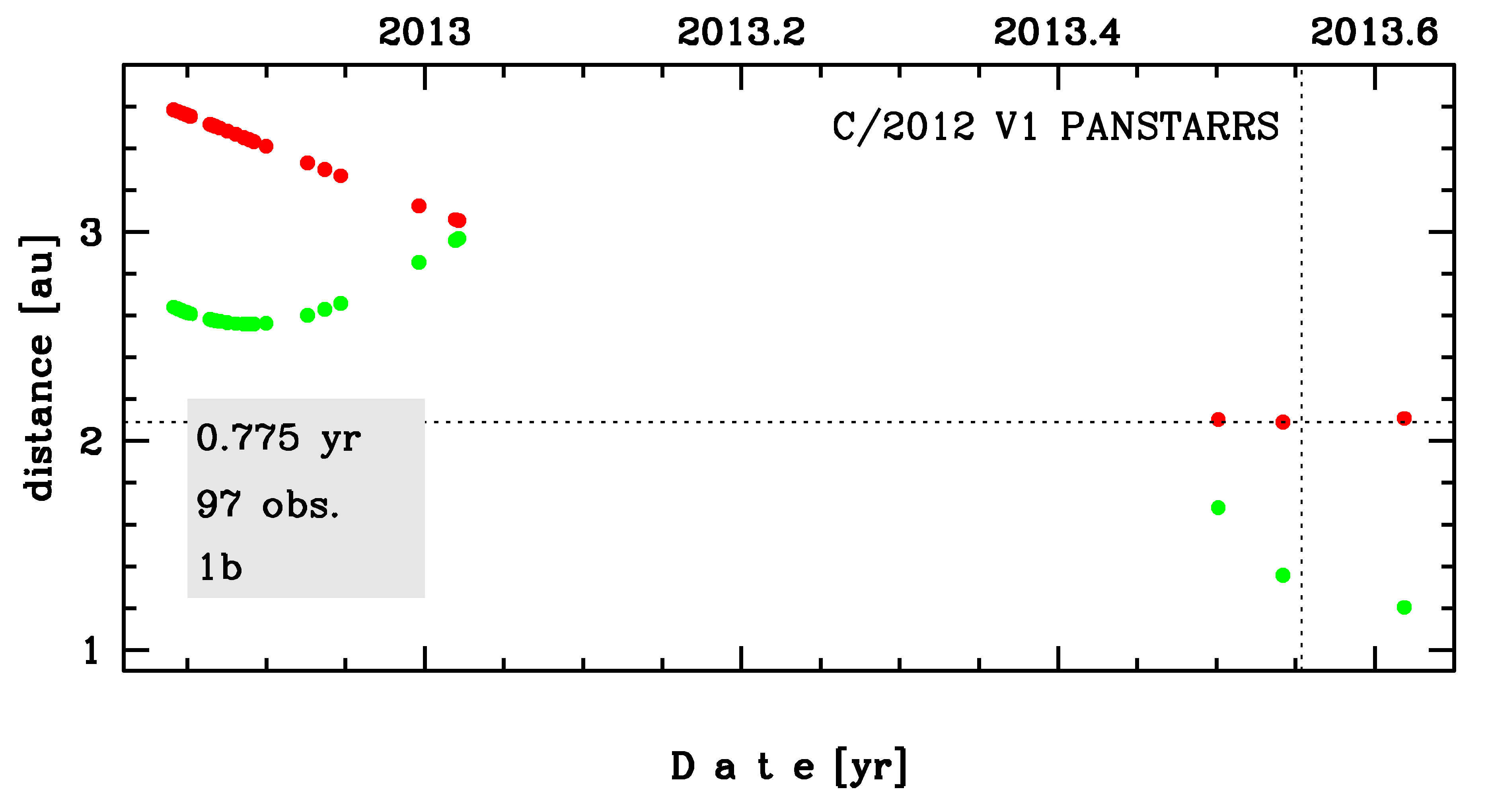C/2012 V1 PANSTARRS
more info
Comet C/2012 V1 was discovered on 3 November 2012 with Pan-STARRS 1 telescope (Haleakala), that is almost 9 months before its perihelion passage. It was observed until 13 August 2013 (see picture).
C/2012 V1 had its closest approach to the Earth on 5 August 2013 (1.163 au), about 2 weeks after its perihelion passage.
Solution given here is based on data spanning over 0.775 yr in a range of heliocentric distances: 3.58 au – 2.09 au (perihelion) – 2.11 au.
This probably Oort spike comet (slightly negative original 1/a) suffers moderate planetary perturbations during its passage through the planetary system that cause a tighter future orbit with a semimajor axis of about 1,300 au (see future barycentric orbits).
See also Królikowska 2020.
C/2012 V1 had its closest approach to the Earth on 5 August 2013 (1.163 au), about 2 weeks after its perihelion passage.
Solution given here is based on data spanning over 0.775 yr in a range of heliocentric distances: 3.58 au – 2.09 au (perihelion) – 2.11 au.
This probably Oort spike comet (slightly negative original 1/a) suffers moderate planetary perturbations during its passage through the planetary system that cause a tighter future orbit with a semimajor axis of about 1,300 au (see future barycentric orbits).
See also Królikowska 2020.
| solution description | ||
|---|---|---|
| number of observations | 97 | |
| data interval | 2012 11 03 – 2013 08 13 | |
| data type | significantly more measurements before perihelion (PRE+) | |
| data arc selection | entire data set (STD) | |
| range of heliocentric distances | 3.58 au – 2.09 au (perihelion) – 2.11 au | |
| detectability of NG effects in the comet's motion | NG effects not determinable | |
| type of model of motion | GR - gravitational orbit | |
| data weighting | YES | |
| number of residuals | 177 | |
| RMS [arcseconds] | 0.36 | |
| orbit quality class | 1b | |
| previous orbit statistics, both Galactic and stellar perturbations were taken into account | ||
|---|---|---|
| no. of returning VCs in the swarm | 0 | |
| no. of escaping VCs in the swarm | 5001 | |
| no. of hyperbolas among escaping VCs in the swarm | 5001 | * |
| previous reciprocal semi-major axis [10-6 au-1] | -17.95 – -15.03 – -12.10 | |
| previous perihelion distance [au] | 8.05 – 8.75 – 9.49 | |
| time interval to previous perihelion [Myr] | 2.36 ± 0.0012 | |
| percentage of VCs with qprev < 10 | 99 | |
| percentage of VCs with 10 < qprev < 20 | 1 | |
| previous_g orbit statistics, here only the Galactic tide has been included | ||
|---|---|---|
| no. of returning VCs in the swarm | 0 | |
| no. of escaping VCs in the swarm | 5001 | |
| no. of hyperbolas among escaping VCs in the swarm | 5001 | * |
| previous reciprocal semi-major axis [10-6 au-1] | -18.13 – -15.19 – -12.25 | |
| previous perihelion distance [au] | 6.32 – 6.93 – 7.58 | |
| time interval to previous perihelion [Myr] | 2.35 ± 0.0012 | |
| percentage of VCs with qprev < 10 | 100 | |
